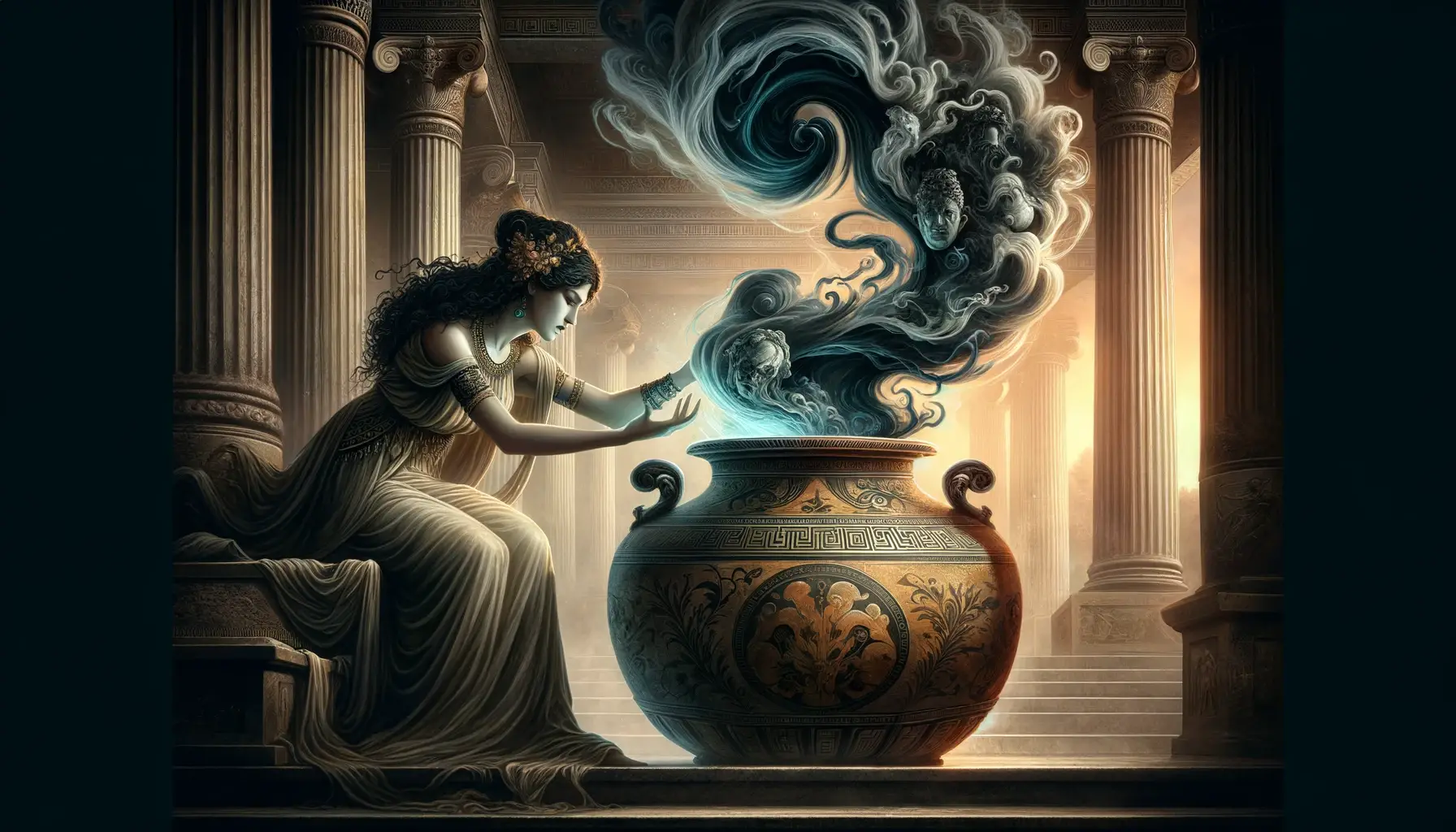The tale of Pandora is one of the most captivating and enduring in Greek mythology, embodying themes of curiosity, consequence, and hope. This overview delves into her history, legend, role, and influence – including her connections to Eve from the Old Testament – while bringing to light some lesser-known facets of her story.
Origin and Mythology
Pandora’s creation in Greek mythology is a remarkable event, as it signifies the first instance of a human being crafted by divine hands. According to the ancient Greek poet Hesiod, her formation was a collaborative effort of the gods, each contributing something special. Hephaestus molded her from earth and water, giving her form; Athena dressed her and taught her skills; Aphrodite gifted her with beauty, and Hermes endowed her with a cunning, deceitful mind.
In the grander scheme of Greek mythology, Pandora’s creation is a pivotal moment, representing a shift in the relationship between gods and mortals. It marks a transition from the age of gods and titans to the age of man. Her story intertwines with that of Prometheus, a titan who defied Zeus by stealing fire for humanity. In response, Zeus commissions Pandora as a means to deliver misfortune to mankind, symbolizing the gods’ control over human fate.
The Role of Pandora in Greek Mythology
Pandora’s most significant role in Greek mythology is associated with the famous “Pandora’s Box” (actually a jar, or ‘pithos’ in Greek). She was sent to Earth to be the wife of Epimetheus, brother of Prometheus, who had defied Zeus by giving fire to humanity. Accompanying her was a jar, which she was instructed never to open. Overcome by curiosity, Pandora eventually opened it, releasing all the evils of the world – sickness, death, and a multitude of other unnamed ills – leaving only Hope trapped inside when she hurriedly closed it again.
Symbolism and Interpretation
Pandora’s jar is a central symbol in her story. The jar’s contents, representing both tangible and intangible evils of the world, symbolize the unforeseen consequences of human actions and curiosity. The fact that Hope remains in the jar offers a dual interpretation: either it is a comforting presence amid suffering or a cruel irony, signifying an unattainable reprieve.
Pandora and Eve
Her narrative also reflects ancient Greek views on women. Pandora, like Eve in the Christian tradition, is often seen as the bringer of hardship to mankind. Both figures are the first women in their respective mythologies, created by a divine being after man was introduced, and both play a pivotal role in the introduction of suffering into the world by succumbing to temptation. In both accounts, their disobedience brought mortality, weakness, conflict and frailty to humanity. However, where Eve’s actions lead to the ‘original sin’, Pandora’s actions are more reflective of human curiosity and the complexities of being bestowed with gifts from the gods.
In some Greek myths, Pandora is said to have given birth to the first mortal child, further cementing her role as the progenitor of the human race, akin to Eve’s role in Abrahamic traditions. Philosophers have often used Pandora to discuss themes of fate, free will, and the human condition, drawing parallels between Greek and Christian narratives of human origin and downfall.
Influence on Culture and Art
The story of Pandora has been a source of inspiration in various artistic domains, including literature, painting, and sculpture. In literature, her tale has been retold and reinterpreted through various lenses, from ancient Greek texts to modern feminist critiques. Some ancient Greek vases depict Pandora being adorned by the gods, emphasizing her role as a divine gift and a curse to mankind.
In art, she has been depicted by renowned artists like Jean Cousin the Elder, who painted “Eva Prima Pandora” in the 16th century, drawing parallels between Pandora and Eve from the Christian tradition. This portrayal reflects the broader cultural tendency to link Pandora with the notion of a ‘fallen woman’ or the bringer of misfortune.
The parallel with Eve has been a subject of interest in Western art and literature. Both Pandora and Eve have been depicted as archetypes of curious women whose actions bring about a change in the human condition. This parallel often serves as a commentary on the perception and treatment of women throughout history, highlighting themes of temptation, innocence, and the burden of knowledge.
Did You Know?
- Pandora and Earthly Women: In some interpretations, Pandora is seen not just as an individual but as a representation of women in general. Her creation is sometimes viewed as a mythical explanation for the hardships of mortal life, particularly as experienced by women.
- Hope’s Significance: The retention of Hope in the jar is a topic of much debate. Some see it as a positive reminder of resilience amidst adversity, while others interpret it as a cruel jest, suggesting that hope is a torment in itself.
- Variations in Myth: There are variations in the myth where Pandora is given a box or a jar by the gods as a wedding gift, which is later opened by her husband, Epimetheus, depicting him as the one responsible for the miseries of the world.
- Pandora’s Daughters: Some lesser-known myths suggest that Pandora had daughters who personified aspects of her attributes, such as Pyrrha, who represents the fire of life.
Final Thoughts
Pandora’s story continues to resonate in contemporary culture, often used as a metaphor for unforeseen consequences, especially in the context of technological and scientific advancements. Pandora’s myth, rich in symbolism and narrative complexity, offers a profound window into Greek mythology. It reflects ancient perspectives on divine intervention, human nature, and the paradoxical coexistence of suffering and hope.
The parallels with Eve highlight a broader cultural tendency to scrutinize the role and influence of women in mythological narratives, shaping our understanding of history, morality, and the human experience. Pandora’s narrative has evolved over centuries, reflecting the changing perceptions of humanity, gender, and the existential dichotomy of suffering and hope.
At Ancient Theory we only use trusted sources to document our articles. Such relevant sources include authentic documents, newspaper and magazine articles, established authors, or reputable websites.






